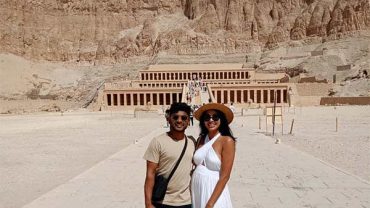Nestled on the west bank of the Nile River, against the Theban hills, lies the archaeological treasure trove of Deir el-Medina Tombs. This historical site, dating back to the New Kingdom of ancient Egypt, holds a unique significance as it was the dwelling place for the skilled artisans and craftsmen responsible for constructing the royal tombs in the nearby Valley of the Kings. Deir el-Medina Tombs, translated as “Monastery of the Town,” provides a rare glimpse into the daily lives and burial practices of these skilled laborers. As we unravel the layers of history in this ancient settlement, we discover not just tombs but a microcosm of a vibrant community that thrived more than three thousand years ago.
The Lives of Artisans
In the heart of Deir el-Medina, the labyrinthine network of narrow streets reveals the remains of well-preserved houses, shedding light on the intimate details of daily life for the skilled artisans. These homes, adorned with vivid murals and adorned with simple yet elegant furnishings, offer a glimpse into the domestic world of the workers.
The artisans of Deir el-Medina were a close-knit community, bound by the shared purpose of creating the final resting places for pharaohs and nobility. Their lives revolved around meticulous craftsmanship, and the tombs they built reflected not only their technical prowess but also their religious beliefs and devotion to the afterlife. The intimacy of this settlement stands in stark contrast to the grandeur of the nearby royal tombs, providing a unique perspective on the multifaceted nature of ancient Egyptian society.
Tombs of Deir el-Medina
The tombs of Deir el-Medina, scattered throughout the site, offer a captivating narrative of burial practices in ancient Egypt. Unlike the grandeur of the Valley of the Kings, these tombs provide a more personal touch, showcasing the artisans’ desire for a peaceful afterlife.
Elaborate wall paintings and hieroglyphics adorn the burial chambers, depicting scenes from everyday life, religious rituals, and the journey to the afterlife. Each tomb tells a story – not just of the deceased, but of the craftsmen who meticulously carved and painted these sacred spaces. The reverence for the dead and the intricate details in the tombs of Deir el-Medina showcase the mastery of the artisans, underscoring their belief in the importance of a well-prepared journey to the beyond. Explore also Beni Hasan Tombs.
Legacy and Preservation
As we explore Deir el-Medina, it becomes evident that this ancient settlement is not just a relic of the past but a testament to the resilience of human craftsmanship. The preservation of the site allows us to step back in time and appreciate the skills and dedication of the artisans who shaped the grandeur of ancient Egypt.
The intricate details of their lives and the artistry embedded in the tombs continue to captivate archaeologists, historians, and visitors alike. Through careful excavation and preservation efforts, we ensure that the legacy of Deir el-Medina endures, allowing future generations to connect with the artisans who contributed to the immortal glory of Egypt’s pharaohs.
Religious Practices at Deir el-Medina
Central to the existence of the community at Deir el-Medina was a deep-seated religious fervor, evident in the rituals and practices that permeated daily life. The inhabitants of this settlement were not just skilled craftsmen but also devout individuals who held a profound belief in the divine.
The temples within the settlement, dedicated to gods such as Hathor and Amenhotep, stood as testament to the spiritual fabric woven into the lives of the artisans. These religious structures served as places of solace and communal worship, reinforcing the sacred bonds that connected the inhabitants to each other and their gods. The meticulous attention to detail in the construction of these religious spaces mirrored the artisans’ dedication to their craft, intertwining the sacred and the secular in the tapestry of Deir el-Medina’s existence.
Challenges and Social Dynamics
While the tombs and structures of Deir el-Medina reflect a harmonious community, the reality of life within the settlement was not without its challenges. The artisans faced demanding working conditions, often working in extreme temperatures to meet the exacting standards of their royal patrons. Yet, amidst these challenges, a sense of camaraderie and solidarity emerged.
The community at Deir el-Medina, isolated from the rest of society, developed a unique social structure. The inhabitants, both men and women, played distinct roles in the daily functioning of the settlement. The challenges they faced, whether natural or societal, forged a resilient community that not only created awe-inspiring tombs but also thrived in the face of adversity.
Influence on Modern Understanding
Deir el-Medina remains a crucial archaeological site that continues to shape our understanding of ancient Egyptian society. The meticulous documentation and preservation efforts by archaeologists have allowed us to reconstruct a vivid picture of the lives of these artisans.
The knowledge gained from Deir el-Medina extends beyond its historical context, providing insights into the dynamics of communal living, religious practices, and the intricate craftsmanship of the time. As we delve into the labyrinthine alleys and peer into the tombs, we unravel not just the secrets of a bygone era but also gain a profound appreciation for the human spirit that transcends time and connects us to our ancient roots.




Comment (0)